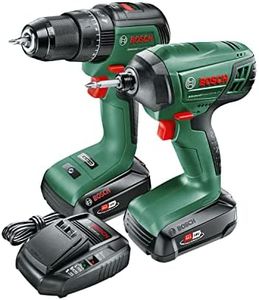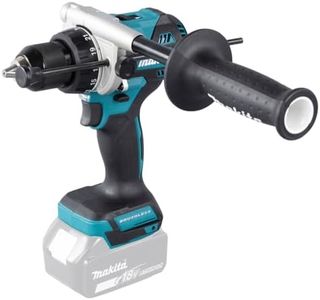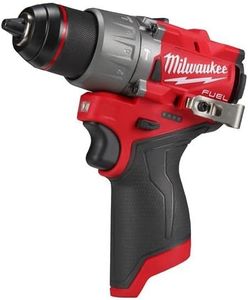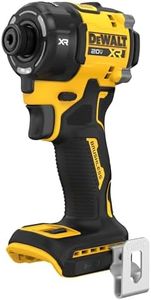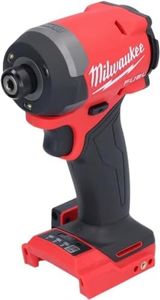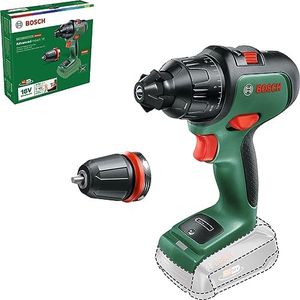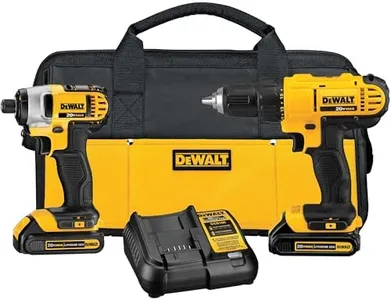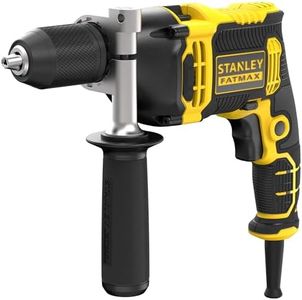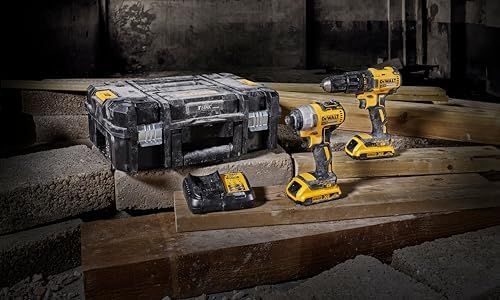We Use CookiesWe use cookies to enhance the security, performance,
functionality and for analytical and promotional activities. By continuing to browse this site you
are agreeing to our privacy policy
10 Best Impact Drills
From leading brands and best sellers available on the web.Buying Guide for the Best Impact Drills
Choosing the right impact drill is all about understanding what sort of tasks you'll be using it for. Impact drills are powerful tools designed to drive screws and bolts more efficiently than standard drills, and they can make your work go a lot smoother if you pick the right one. Think about how often you'll use it, what kinds of materials you'll be working with, and whether you'll need to carry it around or use it in tight spaces. Focusing on the features that really matter for your typical projects will help you find a drill that feels just right in your hand and delivers the performance you need for years to come.Power (Voltage or Amperage)Power in impact drills is typically measured in volts for cordless models and amps for corded ones. This indicates how strong the drill is and how easily it can drive screws or bolts into tough materials like hardwood or metal. Lower values (around 12V for cordless or 4-6 amps for corded) are usually enough for light household tasks such as assembling furniture or drilling into drywall. Mid-range values (14-18V or 7-8 amps) offer a balance of performance and portability, suitable for a wider range of home improvement projects. High power (20V+ or 8+ amps) is best for heavy-duty jobs or frequent use. Pick based on what you’ll mostly use the drill for: lighter power for small jobs, more power if you’ll tackle tough materials or larger projects.
TorqueTorque is the twisting force the drill can apply, usually measured in Newton-meters (Nm) or inch-pounds (in-lbs). Higher torque means the drill can turn tougher, larger screws or work in harder materials without bogging down. For light household tasks, lower torque is sufficient and easier to control. Medium torque fits most home improvement needs, while high-torque models are perfect for driving big fasteners into dense materials. If your projects involve a lot of decking, fence building, or working with thick lumber, more torque will be your friend. Otherwise, for smaller crafts or light repairs, less is more.
Speed (RPM and Impact Rate)Speed is measured in revolutions per minute (RPM), and the impact rate in blows per minute (BPM). Faster speeds help with drilling into softer materials, while higher impact rates excel at driving screws into tough surfaces. Drills with variable speed settings give you the flexibility to start slow for precision and ramp up speed for efficiency. For most users, a two-speed setting is enough: low for tougher, controlled driving; high for quick drilling. If you expect to use the drill for many different applications, variable speed is a helpful feature.
Chuck Size and TypeThe chuck is the part that holds your drill bits. Most impact drills use a hex chuck, commonly 1/4-inch, which works with hex shank bits designed for quick changes. For most home users, a 1/4-inch hex chuck is standard and all you need. This makes it easy to swap bits without tools. If you plan to do more drilling than driving, you might want to consider compatibility with standard drill bits as well. The right chuck size ensures you can use the bits you already have or plan to buy.
Weight and ErgonomicsThe weight and shape of an impact drill affect how comfortable it is to use, especially for long periods or overhead work. Lighter, well-balanced models are less tiring but may offer less power and battery life. Heavier drills might be more suitable for tough jobs but can tire you out quickly. If you expect to use the drill a lot or for extended projects, pay close attention to grip comfort, trigger feel, and overall balance. Choose a drill that feels good in your hand for the types of tasks you do most.
Battery Life (for Cordless Models)If you’re considering a cordless impact drill, battery life is crucial. Most batteries are now lithium-ion, which are lighter and last longer per charge. Battery capacity is measured in amp-hours (Ah): higher Ah means longer run time. Typical household use can get by with lower-capacity batteries (around 1.5-2.0 Ah), while those tackling bigger projects or using the drill often should look for higher-capacity packs (3.0 Ah and above). Also, consider how quickly the battery recharges if you need to work continuously.
Additional FeaturesSome impact drills offer extra features, such as built-in LED lights for working in dark areas, belt clips for easy carrying, or brushless motors for longer tool life and more efficient performance. While these aren’t essential for everyone, they can make your tool more convenient and enjoyable to use. Keep your typical working environment in mind when deciding if these features are worth it for you.

